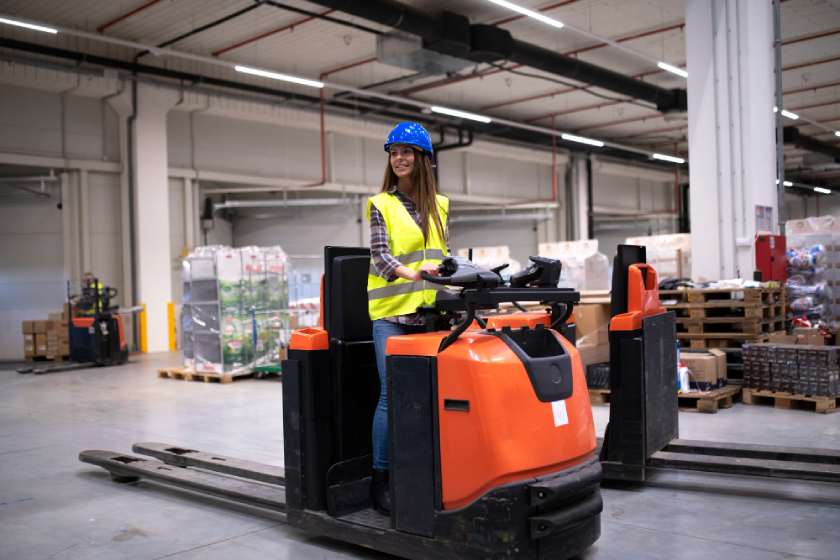In the ever-evolving landscape of material handling, innovation stands as the catalyst for improved efficiency and sustainability. Among the diverse forklift options, the 3-wheel electric forklift has emerged as a versatile and environmentally friendly solution. This thorough exploration will delve into the distinctive features that set 3-wheel electric forklifts apart, unveil the benefits they provide, and discuss their role in shaping the future of material handling.
What Are 3 Wheel Electric Forklifts
A 3-wheel electric forklift is a category of forklift truck propelled by an electric motor, characterized by a distinctive design featuring three wheels. In contrast to conventional forklifts, typically equipped with four wheels, the 3-wheel electric forklift incorporates a single drive wheel at the rear and two wheels at the front. This configuration enhances maneuverability, making it particularly suitable for tasks in compact or restricted spaces, such as warehouses and distribution centers.
Features Of 3 Wheel Electric Forklifts
Let’s understand the distinctive features of 3 wheel electric forklift.
1. Compact Design
Prioritizing maneuverability in restricted spaces, 3-wheel electric forklifts feature a distinctive design. With a single drive wheel at the rear and dual wheels at the front, these forklifts can effortlessly navigate through narrow aisles and crowded warehouse environments. Operators can execute precise turns and maneuver through obstacles effortlessly, streamlining material handling processes.
2. Electric Powertrain Efficiency
In contrast to conventional internal combustion forklifts, 3-wheel electric forklifts utilize electric powertrains. This not only eradicates harmful emissions but also offers a quieter and more energy-efficient solution. This aligns with the growing emphasis on sustainability and eco-friendly practices. The electric motors deliver immediate torque, elevating responsiveness and overall performance.
3. AC Drive Technology
Numerous 3-wheel electric forklifts come equipped with advanced AC drive technology. This technology ensures smoother acceleration and deceleration, precise control, and diminished maintenance needs when compared to conventional DC drive systems.
4. Regenerative Braking System
A notable feature in these forklifts is the regenerative braking system. This technology transforms braking energy into electrical energy, which is subsequently returned to the battery. This not only enhances energy efficiency but also prolongs the lifespan of the braking system. This energy recovery translates into cost savings over the long term. By harnessing and reusing energy that would otherwise be lost as heat, businesses benefit from reduced energy consumption and lower operational costs.
5. Lithium-ion Battery Technology
The power source is a vital element in every electric forklift, and 3-wheel models frequently integrate lithium-ion batteries. These batteries offer extended runtimes, quicker charging times, and are maintenance-free in contrast to conventional lead-acid batteries. The advanced capabilities of lithium-ion batteries result in increased productivity. Reduced downtime for recharging and maintenance means more time spent on material handling tasks, improving overall operational efficiency.
6. Smart Control Systems
Contemporary 3-wheel electric forklifts are furnished with smart control systems. These systems permit programmable performance settings, guaranteeing optimal efficiency for specific tasks. Certain models even incorporate features such as automatic shut-off during inactivity to conserve energy.
7. Ergonomic Design for Operator Comfort
Prioritizing operator comfort, 3-wheel electric forklifts are crafted with ergonomics in focus. Adjustable seating, intuitive controls, and improved visibility collectively contribute to a comfortable and productive work environment.
Benefits Of 3-Wheel Electric Forklift
1. Environmental Friendliness
Shifting to electric power markedly diminishes the environmental footprint of material handling operations. With zero emissions during operation, 3-wheel electric forklifts promote cleaner air quality, rendering them well-suited for indoor applications.
2. Cost Savings
The effectiveness of electric powertrains and the implementation of regenerative braking lead to cost savings. Decreased energy consumption, reduced maintenance expenses, and extended battery life all contribute to a more cost-effective solution over the long term.
3. Increased Productivity
The nimble maneuverability of 3-wheel electric forklifts enables swift navigation through confined spaces, ultimately enhancing productivity. The integration of responsive AC drive technology and smart control systems ensures the efficient handling of materials.
4. Quiet Operation
Electric forklifts function with substantially lower noise levels compared to their gas-powered counterparts. This not only fosters a more agreeable working environment for operators but also facilitates nighttime or 24/7 operations in noise-sensitive areas.
5. Versatility in Application
The versatile applications of 3-wheel forklifts arise from their compact design and electric power. Whether in retail settings or manufacturing plants, these forklifts can adeptly adjust to various environments, providing a solution for a range of material handling needs.
Conclusion: Shaping the Future of Material Handling
In the pursuit of sustainable and efficient material handling practices, 3-wheel electric forklifts have emerged as pioneers. Their distinctive blend of features, encompassing a compact design, electric power, and intelligent control systems, positions them as transformative forces in the industry.
With businesses emphasizing environmental responsibility, cost-effectiveness, and operational efficiency, the adoption of 3-wheel electric forklifts is gaining traction. These forklifts not only provide immediate advantages in terms of decreased emissions and lower operating costs but also align with a long-term vision of sustainable material handling.



